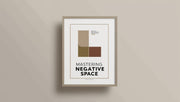One of the most powerful yet often overlooked elements in design is negative space. Also known as white space, negative space is the empty or unused area around design elements. While it may seem like “blank” space, when used effectively, it enhances clarity, balance, and user experience.
In this blog, we’ll explore how to master negative space in design, why it’s important, and how top designers use it to their advantage.
What is Negative Space?
Negative space refers to the area between and around the main elements of a design. It can be background space, spacing between lines of text, margins, or even gaps between graphic elements.
This concept is essential for guiding visual flow, emphasizing content, and creating breathing room within the layout.
Keyword Highlight: negative space, white space in design, visual spacing
Why Negative Space Matters
Many beginner designers fill every inch of space with text or visuals. But design clutter confuses viewers and detracts from the message. Negative space creates visual hierarchy and improves readability, focus, and aesthetic balance.
Keyword Highlight: importance of white space, design clarity, visual hierarchy
Types of Negative Space
-
Macro Negative Space
Large, open areas like the background or wide margins that frame content. -
Micro Negative Space
Small spaces like the padding between buttons, line spacing in text, or space between list items.
Keyword Highlight: macro negative space, micro white space, layout spacing techniques
How to Use Negative Space Effectively
1. Improve Readability
Text that’s too tightly packed is hard to read. Use proper line spacing, margins, and padding to make the content easier to consume.
Keyword Highlight: readable typography, line spacing design, text layout
2. Create Focal Points
White space draws attention to key elements like CTAs (call-to-action), headlines, or product images.
Keyword Highlight: design focus areas, call-to-action visibility, focal point design
3. Establish Visual Hierarchy
Well-structured negative space helps users understand what’s most important on a page.
Keyword Highlight: visual hierarchy design, element prioritization, user-friendly layout
4. Convey Elegance and Sophistication
Luxury brands often use abundant white space to project elegance, minimalism, and quality.
Keyword Highlight: minimalist design, premium design aesthetics, luxury branding layout
Examples of Negative Space in Action
-
Apple's Website: Clean design with generous white space enhances product focus.
-
Google Search Page: A perfect example of functionality using negative space.
-
Magazine Layouts: Effective use of margins and text spacing for readability and aesthetics.
Keyword Highlight: white space examples, negative space in web design, editorial design spacing
Common Mistakes to Avoid
-
Overcrowding Elements: Trying to fit too much on one page leads to confusion.
-
Ignoring Mobile Layouts: Ensure your spacing translates well on all devices.
-
Using Inconsistent Padding: Inconsistency disrupts the visual rhythm.
Keyword Highlight: design mistakes, mobile layout spacing, consistent UI spacing
Tools That Help Manage Negative Space
-
Figma – Allows easy margin and padding control
-
Adobe XD – Ideal for wireframing with spacing guides
-
Sketch – Offers smart layout features for spacing
Keyword Highlight: design tools for spacing, Figma spacing tools, UI layout software
Conclusion
Negative space is not just an empty area—it's a strategic design element that enhances user experience, clarity, and professionalism. When used effectively, it transforms cluttered designs into elegant and impactful compositions. At DesignersMeet.com, we encourage thoughtful use of white space in every project to elevate design quality and communication.




